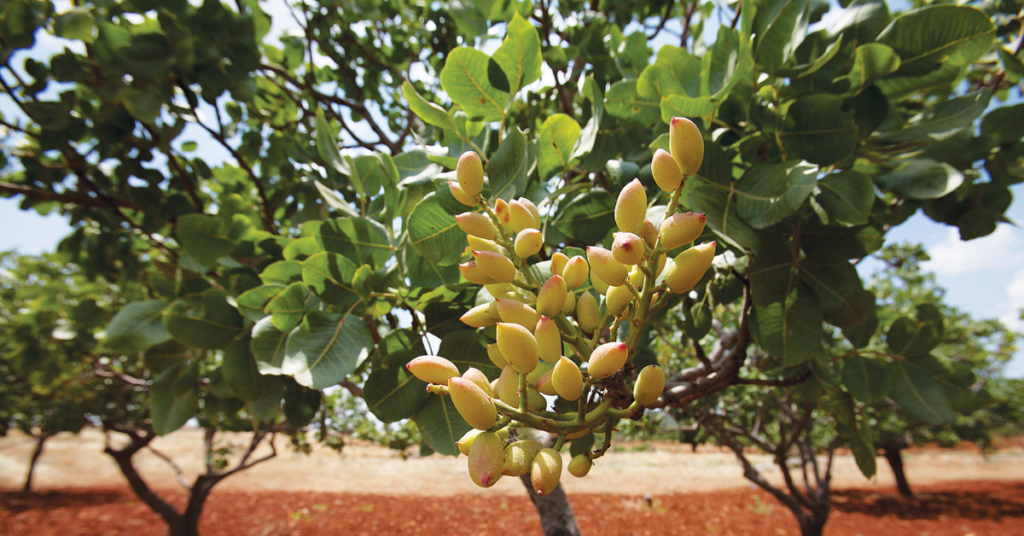
Sustainable innovations
Innovation continues to thrive in the agriculture industry, and that’s been great news for tree nut growers who are taking advantage of new tools, technology and tips to help with crop management, yield and the overall environment.
Many of these innovations are aimed at sustainability, which is a major focus for tree nut growers.
POLLINATOR HABITAT
Josette Lewis, chief scientific officer of the Almond Board of California (ABC), has seen many growers this past year respond to the opportunity to add pollinator habitat in and around their orchards.
This includes early bloomers for pollinators, such as honeybees in the orchard or native pollinators, and habitats outside the orchard, such as hedgerows or floral strips.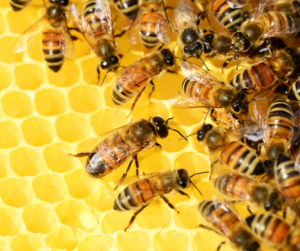
ABC now has 170 acres of orchards registered as bee- friendly farms, which requires a variety of different practices, Lewis said. “Growers are naturally attuned to the importance of pollinators and see the market value of adding habitat and being able to tell a really powerful story about their commitment to biodiversity,” she said.
SOIL HEALTH
The American Pistachio Growers (APG) recently received a $5 million Healthy Soils Program Block Grant from the California Department of Food and Agriculture to help growers implement sustainable practices that align with healthy soils.
“Right now, we’re seeing a lot of on-farm practices. They are expensive to implement, but it’s what most want to try, and these grants really help the growers with that,” said Wes Wilson, APG’s director of member services and communications. “Things that help with compost, cover cropping and alternative carbon amendments.”
For example, seaweed applications and microalgae applications are being used to help boost organic matter in the soil.
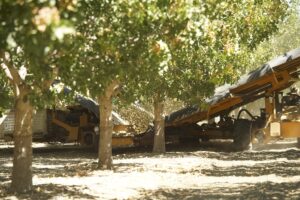
“People are really working to reduce tillage and overall reduce the number of passes in the field or orchard, which cuts down on emissions and helps with water infiltration,” Wilson said.
A big focus of growers when it comes to sustainability concerns irrigation and new technology, including adding more efficient pumps, soil moisture probes and utilizing real-time data for weather. These improvements make controlling irrigation autonomous.
“It can be done by phone or you can tie it into your soil monitoring weather systems, so you don’t even need to do something if it rains. It just knows,” Wilson said.
WHOLE-ORCHARD RECYCLING
Roger Duncan, orchard crops advisor for UC Cooperative Extension in Stanislaus County, has seen an increased interest in whole-orchard recycling over the last couple of years.
“It’s become very common around here,” he said. “There’s been a lot of work being done in chipping all the trees and reincorporating all the material back in the ground before planting the next orchard. It’s a pretty large percentage for almonds and walnuts.”
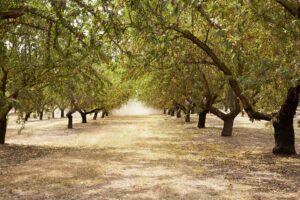
As whole orchard recycling was pioneered for almonds, Lewis noted she’s seen rapid adoption of the technique among almond growers.
It was born out of necessity as the San Joaquin Valley Air Pollution Control District has outlawed the burning of agricultural residue, she said. “Finding places to usefully put the trees at the end of the orchard is a necessity, and this is a great opportunity for growers to sequester an enormous amount of carbon in the soil,” Lewis said.
Replanting in the same location benefits both the environment and the grower agronomically.
“Research shows it improves water-use efficiency yield up to 20% over the first five years of the next orchard,” Lewis said. “As of last year, half the orchards that renewed were practicing this.”
REGENERATIVE AG PROCESSES
More focus today is on the regenerative ag processes movement, as tree nut growers are utilizing shells and nut powder for things such as mulching, composting, converting to biochar and even erosion control.
Early stages of recent research among some growers has shown shells can be a good source of potassium, and, if put back as a compost application, can provide most if not all of the trees’ potassium.
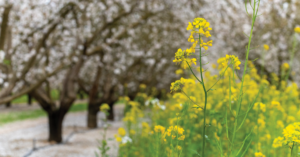
“One of the things I love with regenerative is cover cropping,” Lewis said. “There’s been a three-fold increase in the adoption of planted cover crops in almonds in the last few years as growers have recognized it’s a technique that can be used to improve water infiltration.”
She also said a large percentage of California nut growers use compost, usually green waste.
“There has been a large rate of adoption of compost as a soil amendment to both increase the organic matter over time and also as a nutrient source,” Lewis said. “We’re also seeing a lot of progress on more frequent and low-dose application of fertilizers, particularly nitrogen fertilizers.”
For almonds, Duncan said there’s a lot of interest in using an off-brand harvesting system and machinery that can go up and over or under the trees to catch the nuts instead of sweeping them up.
“If you can catch the nuts and haul them out of the orchard without letting them touch the ground, it allows cover crops to grow and you can apply compost or other organic material to the ground without having to worry about it interfering with the harvest process,” he said. “It’s not widely adapted and there are still some things to work out, but there’s rising interest.”
He also noted there’s much incorporation of organic materials, though research is ongoing in the value of applying compost and benefits to trees.
IPM
Also making noise going into 2024 are some organic farming methods or integrated pest management (IPM) techniques that will be beneficial for growers.
“We’re seeing growers utilize IPM with mating disruption; so the introduction of sterile insects where we’re trying to ‘un-breed’ the population,” Wilson said. “There is some good data people are seeing surrounding that.”
Knowing pests are a constant challenge for growers, ABC has been funding IPM research for decades.
“An interesting new activity we are getting launched is to do third-party evaluation of some biopesticides,” Lewis said. “This is adding another tool in the suite of IPM options for conventional farming systems.”







